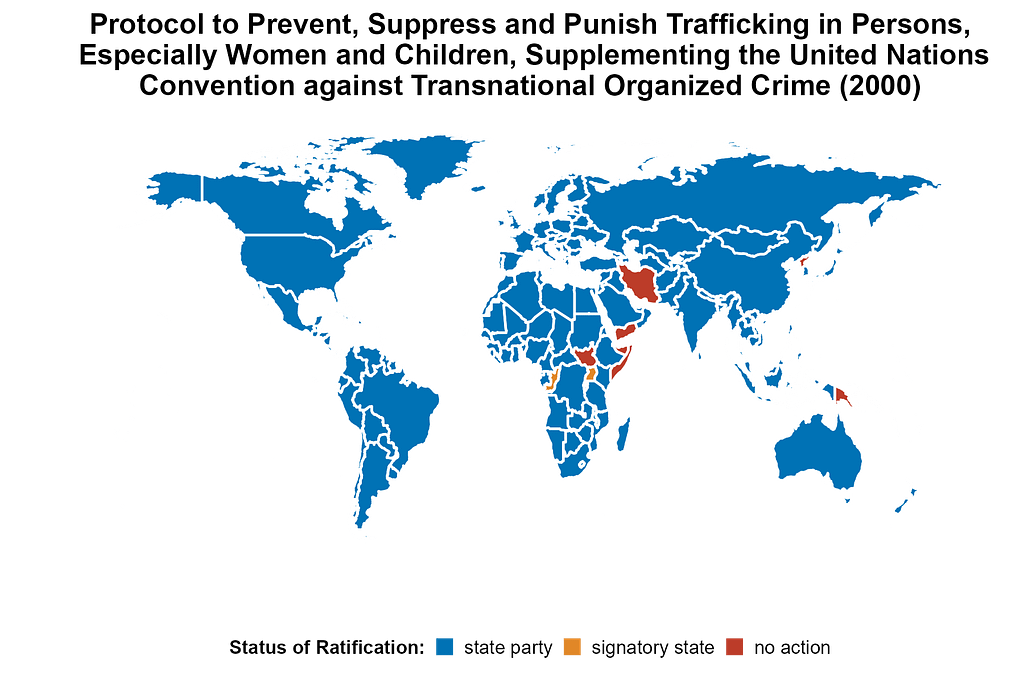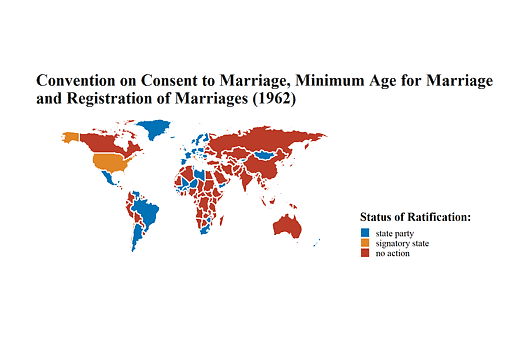ELAINNA HODGE & SKYLAR TANSKI
In this post, we examine the ratification status of The Protocol to Prevent, Suppress, and Punish Trafficking in Persons, Especially Women and Children, an adjunct to the United Nations Convention against Transnational Organized Crime of 2000. Entering into force on December 25, 2003, it aims to diminish human trafficking while respecting the rights of those involved.
The Protocol presents a multifaceted strategy to achieve this objective. For example, recognizing human trafficking as a transnational phenomenon, the treaty seeks to establish a framework for prosecuting traffickers that can be universally applied regardless of the location where they operate. This uniform approach is designed to serve as a stronger deterrent against human trafficking, ensuring consistent treatment for traffickers upon arrest, irrespective of the specific circumstances of their crimes.
Beyond punishment, implementing such a protocol serves to safeguard trafficked individuals from human rights violations. Trafficking of persons occurs with a variety of motives, most frequently including prostitution, physical labor, forced sexual exploitation, and organ removal. The instrument creates a global standard for defining what constitutes human trafficking (Raymond 18). It protects those who do not conform to the definition of traffickers, as well as victims of trafficking who may be suspected of participation, establishing a framework to preserve their rights and ensure their protection. This includes a wide spectrum, including purchasers of sex work, individuals unable to migrate legally, victims, and even criminal groups. Furthermore, alongside this treaty, the Protocol Against the Smuggling of Migrants by Land, Sea, and Air was developed to address similar yet distinct crimes that fall outside the scope of trafficking.
To track the current ratification status among states, we developed a choropleth map utilizing the ggplot2 package in R. The data was extracted from the UN Treaty Collection’s website, categorizing UN member states into three distinct groups. Those states that have neither ratified nor signed the instrument are categorized as having taken “no action”. A “state party” refers to a state that has ratified the treaty or adhered to its regulations. Meanwhile, a “signatory state” denotes a state that has signed the instrument but has not yet ratified it.

As the map denotes, the Protocol enjoys widespread support. By providing a more comprehensive definition of human trafficking, the Protocol has “informed regional, sub-regional, and national counter-trafficking frameworks”. This approach ensures a consistent response to transnational organized crime, bolstering the deterrent effect against trafficking across all signatory states. Moreover, the treaty delineates clear guidelines for judicial cooperation among states and facilitates information sharing. Consequently, states participating in this treaty can collaborate effectively to prevent trafficking, significantly enhancing their collective success in combating this crime. developing new or strengthening existing tools to combat this crime.
In conclusion, the Protocol’s standardized approach to transnational organized crime enhances the deterrent impact against human trafficking across all state parties. Furthermore, the instrument’s provision for judicial collaboration and information sharing cultivates collective efforts among participating states, bolstering a stronger, united front against human trafficking and advancing the fight against this pervasive global problem.
Want to learn more about this legal instrument?
Data on this convention’s ratification status is available on the World Politics Data Lab’s GitHub page. The most recent dataset was uploaded to the repository on October 1, 2023.
For more information on the convention’s history and its current application, please refer to the following academic writings:
Ezeilo, J.N. (2015) “Debate-Achievements of the Trafficking Protocol: Perspectives from the former UN Special Rapporteur on Trafficking in Persons,” Anti-Trafficking Review, 4.
Raymond, J.G. (2002) “The new UN trafficking protocol,” Women’s Studies International Forum 25(5): 491-502. About the authors:
Elainna Hodge is a Junior majoring in Political Science and Spanish and minoring in Law Justice and Society at Drew University.
Skylar Tanski is a third-year Drew University student majoring in French, International Relations, and Women’s and Gender Studies.


